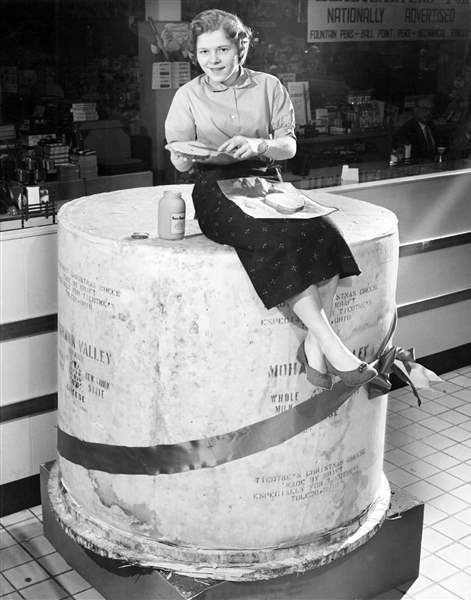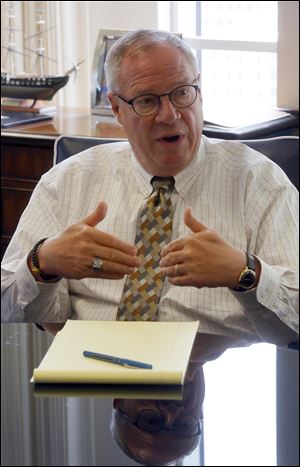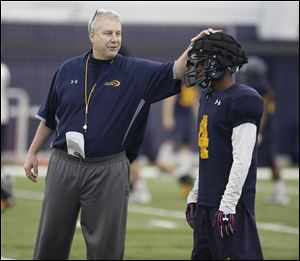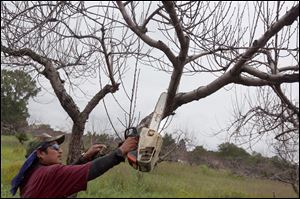
5 things you may have missed in weekend editions of The Blade: 8/25
8/25/2014
Preparing a cheese sandwich atop Tiedtke's annual Christmas 2-ton cheese is Evelyn Durdel in this 1955 file photo. The cheese was 5 feet high and 4 and a half feet in diameter.
The Blade
Buy This Image

Preparing a cheese sandwich atop Tiedtke's annual Christmas 2-ton cheese is Evelyn Durdel in this 1955 file photo. The cheese was 5 feet high and 4 and a half feet in diameter.
1. The Blade, Andersons reviving Tiedtke’s Christmas tradition
For many years, at Christmas, Tiedtke’s would purchase and display a mammoth cheese weighing as much as 2 tons. Old photos show attractive young women perched on top of the behemoths before the cheese was then sliced and sold to customers, selling out within just a few days.
On Nov. 15, The Andersons and The Blade plan to rekindle the Christmas tradition beloved by so many in this city: the ceremonial slicing of a 3,200-pound mammoth round of cheddar cheese for the holiday season.
As The Blade wrote in an article on Dec. 7, 1994, this “may have been the single biggest collective memory of all” for those who would stand in line to see, and purchase a portion of, the enormous Tiedtke’s Christmas cheese.
We all know that you can't go back and recapture that time. Tiedtke’s has not only closed, but its building, which used to stand on Summit Street, burned down in 1975 in the midst of demolition.
But that doesn’t mean that some of the memories can't be revived.

Mayor D. Michael Collins speaks during an Aug. 18 interview with The Blade at the mayor's office.
2. Water crisis leaves confidence void, Toledo mayor says
A new crisis has emerged from the one that occurred three weekends ago, when toxic algae had such a grip on Toledo’s tap water that the metro area’s 500,000 customers were told not to drink or touch it.
It is, according to Mayor D. Michael Collins, a crisis of confidence.
It goes well beyond a region licking its wounds and trying to remake its tarnished image after photos of vile-green goop spread like wildfire across the Internet, making Toledo — one of the most vital port cities along the water-blessed Great Lakes — a strangely ironic poster child for global water pollution, even in Third World Africa.
The hurt, he said, lingers in the hearts and souls of many metro-area residents who remain so skittish about the city’s tap water they had another run on bottled water Thursday — clearing out shelves of many local stores — in response to unsubstantiated rumors circulating across the Internet’s social-media platforms.

Jon Heacock, University of Toledo football team's assistant head coach/defensive coordinator/safeties coach talks to Corey Jones, during spring practice.
3. UT's deep, talent-filled roster hopes to win MAC
Northern Illinois created the Mid-American Conference blueprint for national recognition.
In 2014, the University of Toledo has the opportunity to follow it.
Explicitly stated or not, everybody in the MAC wants what the Huskies created for themselves in the past four seasons. Northern Illinois was able to recruit talented players and turn them into college successes. It saw the right teams at the right times — like Purdue, Kansas, and Iowa in down years — and it consistently cleaned up against the bottom of the league. The Huskies mostly won their big games and made themselves the best team in the MAC West, at Toledo’s expense.
Now the Huskies have lost their three best players from last year’s team, while the Rockets return 18 of 22 offensive and defensive starters.
The Rockets’ schedule is challenging, but UT coach Matt Campbell repeatedly said this summer that this is the deepest roster he has seen at Toledo.

Left to right Father, Jeff Walker, associate pastor at St. Rose Church in Perrysburg, St. Rose School Principal Bryon Borgelt, Assistant Principal Keri Struckholz, and Administrative Assistant Kathleen Schramm have ice water dumped on them for the ALS Ice Bucket Challenge by eighth graders in back (left to right) Carter Higgins, 13, Justin Batdors, 13, Emily Spackey, 13, and seventh grader Noah Zak, 13.
4. ALS ice bucket challenge an issue for many area Catholics
A local Catholic priest and Catholic educators proceeded with the ALS Association Ice Bucket Challenges on Friday but donated to groups other than the association, whose research is opposed by the church.
The challenge, which has soared to national prominence on social media such as Facebook as participants dump cold water with ice cubes over their heads to raise money for ALS research and then challenge others to do the same, is controversial among Catholics.
The Archdiocese of Cincinnati this week told 113 Catholic schools in its jurisdiction to “immediately cease” plans for such ice bucket challenges because it said the ALS group funds embryonic stem cell research, which was “in direct conflict with Catholic teaching.”

Celestino Carranza cuts down a dead peach tree at MacQueen Orchards in Holland. Jeff MacQueen, the orchard's owner, said the cold winter had killed about half their peach tree acreage. More than 1,000 trees on 10 acres will have to removed and replanted.
5. Puny peach crop blamed on bitter cold that killed many farmers’ trees
January’s infamous polar vortex has claimed yet another victim: fresh peaches grown in northwest Ohio, usually a tasty treat this time of year.
Peach trees in Ohio, Michigan, and parts of western Pennsylvania were devastated by sub-zero temperature this last winter, leading to an August crop that could barely fill a barn.
Ohio fruit farmers, who almost exclusively sell their products at local markets, have had to supplement their peaches with produce from elsewhere to have any peaches to sell to customers.
“There’s not much to talk about with the peach crop because, frankly, there isn’t one,” said Bill Dodd, president of the Ohio Fruit Growers Marketing Association.
“There might have been a few farms down south by the Ohio River that weren’t affected, but for the most part this year was a disaster,” he said.